The situation of Quinton Byfield is a unique one. Not his status as a high pick – second overall in the 2020 Draft – but one of heavy playoff pressure without a lot of NHL success. High picks usually find themselves on their team’s top line at the age of 20 because they’ve had very good age-18 or age-19 seasons. That is not true for Byfield, who has eight career goals in 99 regular season games and had below-average expected goals impacts in his first two seasons, per Evolving Hockey.
Early in the 2022-23 season, the Los Angeles top line was struggling. Through Christmas, they were scoring just 2.7 goals per 60 minutes at 5-on-5 with Adrian Kempe and Anze Kopitar on the ice, allowing 2.5, and that was not nearly good enough for a team that had hopes of a Stanley Cup run (all per Natural Stat Trick). Kevin Fiala did not really mix well with them and while Gabriel Vilardi was fine there, they really wanted to use his skills to help bring some scoring to the third line (which was a success). Byfield was on the roster early in the season, but pushed into a minimal role. He went back to the AHL, put up 9 goals and 15 points in 16 games, and was back on the NHL roster in December. That is when things really changed.
To put into perspective the impact Byfield had on the top line in the second half of the regular season, here is how the top line fared by expected goals for/against at 5-on-5 this season without him (via HockeyViz, and the red areas on offence are where they’re creating offence at high rates while the red areas on defence are where they allowed offence at high rates):

That is a lot of shots on offence from outside the danger areas around the crease, and from the literal blue line for some reason. Conversely, bad numbers on defence as well.
Of course, we wouldn’t be here if there weren’t improvements, so here’s how the top line fared with Byfield:
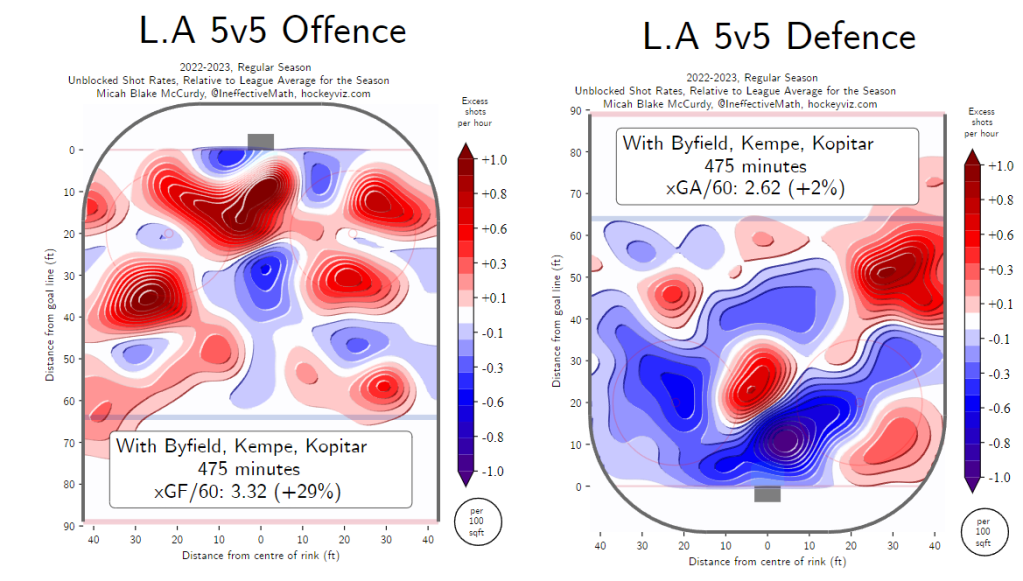
While the expected goals-for numbers are basically the same, we can see the change in offence. The shots from the circles are still there, but the plethora of shots from the blue line are mostly gone with more emanating from the mid-low slot areas. In fact, the line took fewer shot attempts per minute with Byfield than without him, but the added shots from more dangerous areas led to more goal scoring. In fact, their goals jumped from 2.7 per 60 minutes all the way to 4.0 per 60 minutes, increasing by nearly 50%. That is… a lot.
The question is why is Byfield succeeding where other, good offensive players like Fiala and Vilardi (relatively) failed? The first answer is that it’s not strictly about playmaking. It certainly is part of it, but not the whole story. (I will say that I think Vilardi probably would have done well, long-term, but bad shooting percentages in a small sample made it tenuous, at best.)
Using data that is tracked by Corey Sznajder, we can take educated guesses at who the best playmakers are in the league and on a team. One way to help in this regard is scoring chance assists per 60 minutes at 5-on-5, or the rate at which a player assists on a teammate’s scoring chance. The leaders in this regard for 2022-23 include Mitch Marner, Connor McDavid, Artemi Panarin, and Mark Stone, for reference. In the sample of forwards I have (249 forwards with at least 200 tracked minutes), the league average SCassist/60 is 3.1. Among regular Los Angeles forwards this season, just four exceeded that league average:
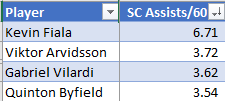
Notice that half the list are guys that were eventually moved off the top line. In other words, if they weren’t willing to move Arvidsson up because of his chemistry with Phillip Danault, and Byfield didn’t work out, they were, in a word, fucked. It did work out, though, so let’s get specific as to why.
For starters, let’s look at what was going wrong earlier in the season. Again, generating shot attempts wasn’t necessarily the problem, but it was getting to quality scoring areas other than Adrian Kempe’s One-Timer Wheelhouse. I thought I’d watch some shifts from bad offensive games in the first half of the season from the Los Angeles top line. We are going to look at one home game (December 17th vs. San Jose) and one road game (December 23rd in Arizona). Neither of those teams were particularly good defensively this season, yet the Kings top line struggled mightily to generate high quality offence against them.
[Note: This is the part where I learned when the NHL’s streaming rights in Canada went to Sportsnet Now for the 2022-23 season, they installed encrypted media extensions that make it very, very hard to create GIFs or screen shots, unlike in prior seasons with Centre Ice. There are workarounds, and I’ll hopefully get to that at some point this summer, but my intention was to create GIFs that illustrate the points made. Instead, we’re going to have to settle for screenshots of my computer screen taken with my phone. The NHL in 2023: always putting fans first.]
The first few screen shots are from the San Jose game, and tries to encapsulate the offensive problems they had early in the season. First, an errant Sharks pass around the offensive blue line creates a neutral zone turnover. It gives space for Adrian Kempe to wrangle the puck:

And gain the offensive blue line:

Once the blue line is gained and the offensive-zone play starts to develop, what does Kempe do? Goes right to the net and… stands there:

Now, this is a player who does score goals around the crease, but he also has a lethal shot that he rips from the circles (as evidenced earlier by the shot maps for the top line). Over the last three seasons, Kempe has nine goals off tips/deflections in 216 regular season games. For reference, Vilardi has 11 such goals in just 142 games, and Colorado’s Gabriel Landeskog also has 11, but in 105 games. It is something Kempe can do, and can be efficient when he does it, but it’s not his strength, and just standing in front limits options for your teammates because you’re not tying up a defenceman. At that point, they basically have to force a shot to the net from wherever and hope that Kempe can get a stick on it, or tap in the rebound. They ended up forcing a Fiala one-timer from a bad spot, which was blocked, and the puck went back the other direction. It was a great start that fizzled into nothing.
At the start of the second period of that same game, we run into another issue. Kopitar takes a neutral-zone pass on his backhand with his back facing the opposing goalie, so he just soft-dumps the puck into the corner:

Kempe chases it down, but he’s slow on the forecheck so he doesn’t get in first, and just pins a Sharks defenceman against the boards:

But there is a second man for San Jose providing coverage that retrieves the loose puck Kempe failed to really challenge for. He wraps it to a Sharks forward on the boards and he chips the puck immediately out of the zone:

A soft dump-in with back-sided pressure resulted in the puck exiting the zone in about eight seconds. The funny thing is that Los Angeles re-organized in the defensive zone and turned back to the offensive zone, and that rush resulted in two shots on goal. The first was a Mikey Anderson distance shot off the rush:

And the second was also a Mikey Anderson shot, this one a one-timer, and again from distance:
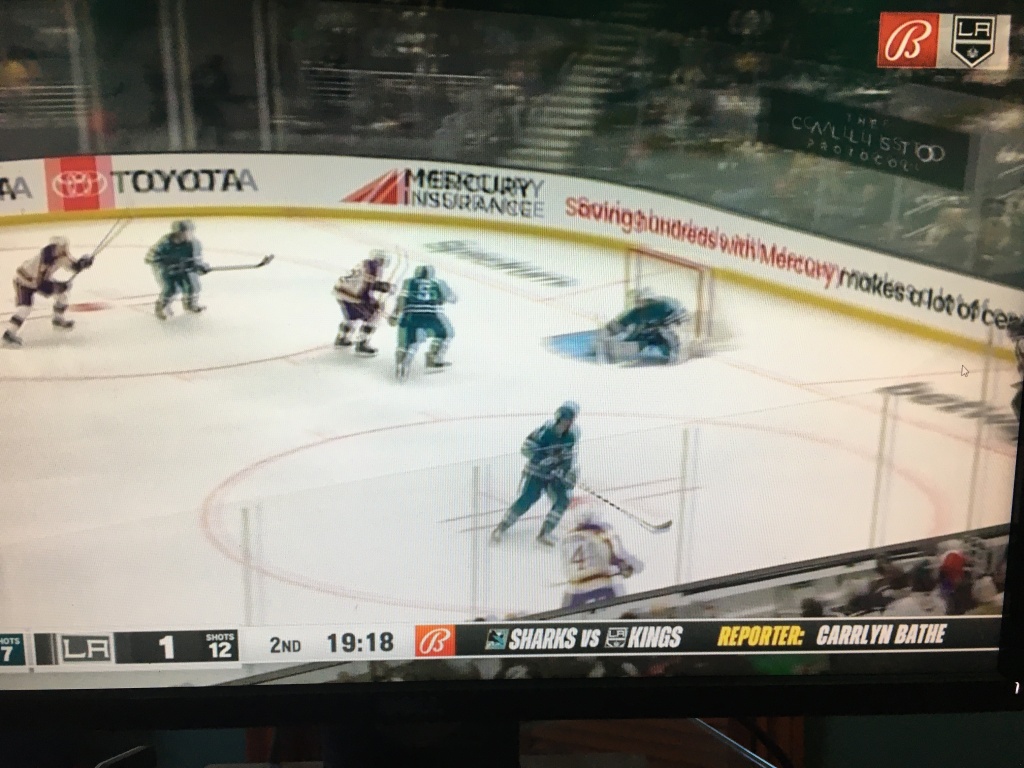
Once more: apologies for the blurriness. Direct your anger to Rogers Sportsnet.
Regardless of the photo quality, here we have three distinct examples of what was going wrong with the top line.
- Entry 1: A controlled entry off a neutral-zone turnover the results in a blocked shot from distance with the line’s sniper standing in front of the goalie for several seconds.
- Entry 2: A dump-in that fails spectacularly because of a lack of timing and support (and also Kempe just pinning a player and not even bothering for the puck).
- Entry 3: A controlled entry off a defensive zone regroup that results in two shots on goal, both from the same defenceman, and neither approaching what could be considered a quality scoring chance.
Again, it wasn’t necessarily that they couldn’t generate shots, but that the quality of the shots wasn’t very good even with clean zone entries. And the ability to create clean zone entries was, in this game, lacking.
Now we get to the Arizona contest, the last before the Christmas break, and one of the last games the team goes without Byfield on the top line. Fiala is still there, so let’s look at a couple plays.
The first is another clean entry for the Kings. They turn the puck over at their blue line and Kempe gains another controlled entry:

This ends up with a couple missed plays and Fiala eventually chasing down a loose puck in the corner:
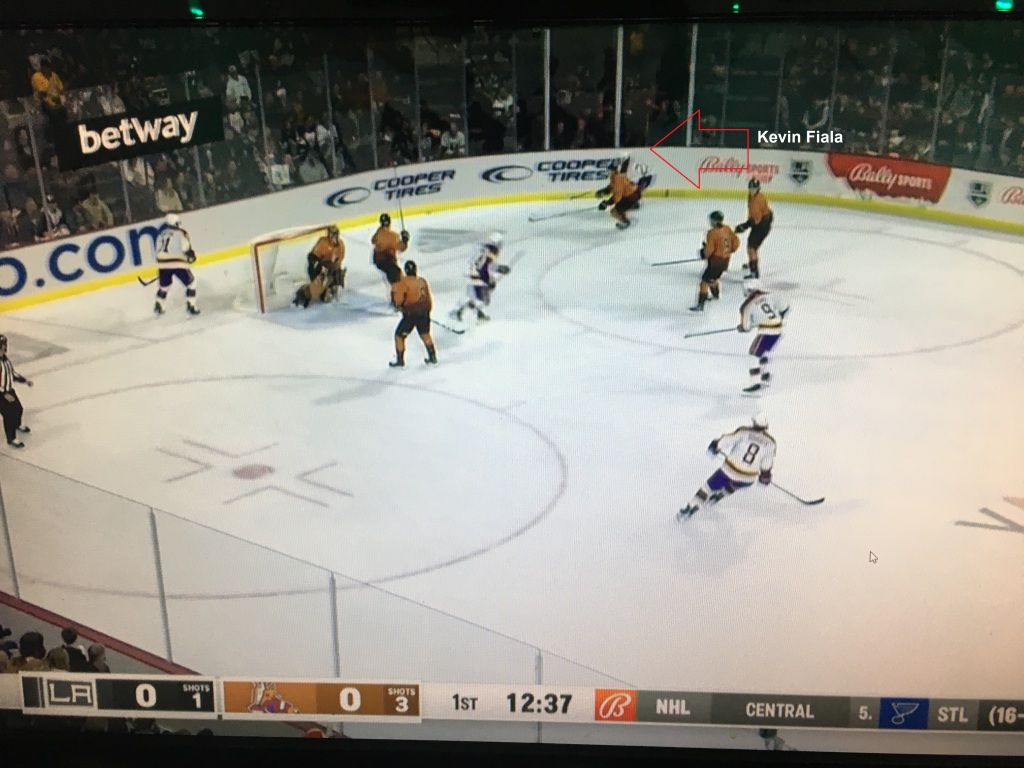
And then Fiala chips the puck to Kopitar, but it’s cut off by an Arizona defender, and chipped passed Kopitar (you can see him behind the net with his head turned because the puck is about to get past him):

Arizona recovered the puck and went the other way.
Early in the second period, the Kings get an offensive zone face-off and send out the Kopitar line. They win it cleanly to Matt Roy, who just fires a wrist shot with no screen right to the Arizona goalie:

One clean entry, one cleanly-won offensive zone face-off, and we get one (1) shot attempt, which is on net with no traffic, and is from about 55 feet. That sums up the Los Angeles offence from the top line through the end of calendar 2022.
Byfield is on the roster at this point, and gets moved to the top line on New Year’s Eve. We are going to look at two games: January 3rd at home to Dallas and February 28th on the road in Winnipeg. They are both Western Conference playoff teams, so it makes a nice barometer for where they stood in the second half nearly two months apart.
It didn’t take long for Byfield to make an impact. Less than a week after joining the top line, Los Angeles beat Dallas 3-2 in Los Angeles, with Kopitar and Kempe each scoring. Just one was at 5-on-5, though, so let’s look at the goal.
The game is nearing the mid-point of the second period and the game is tied 1-1. Dallas had just scored a minute earlier, and the Kings were looking to reply. For this, we are going to review Byfield’s entire shift because it is a masterclass in how to keep generating offence even when the first couple of attempts go wrong, and to create something out of nothing.
We are going to first highlight his defensive zone work. His defenceman gets the puck behind the net and Byfield curls down low in the zone to race up the ice alongside his defenceman:
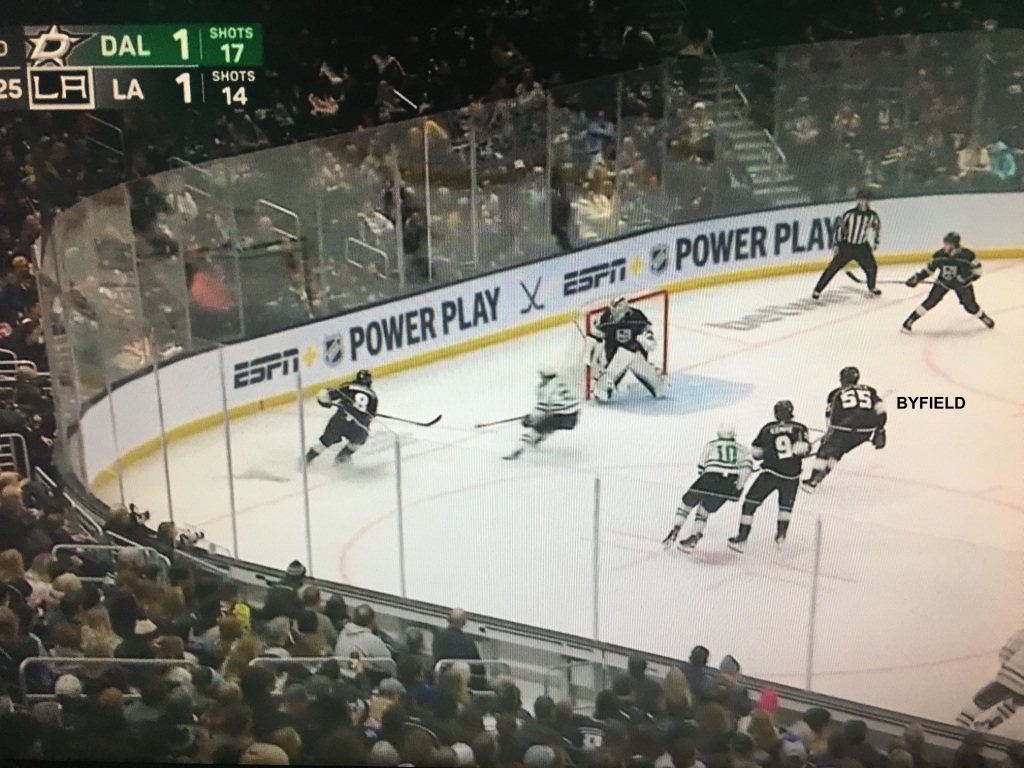
This pushes the Dallas defencemen back as they both take off alongside the speeding Byfield:

And now there’s a clean cross-ice pass to be made to get the puck into the Dallas offensive zone with control:

However, this play results in nothing as an attempted blue-line entry pass by Kempe is intercepted by Dallas and the puck goes back toward the Los Angeles net.
Byfield doesn’t stop there, though. Seconds later, Los Angeles regroups with the puck in the neutral zone and get the puck to Byfield on his forehand:

However, he doesn’t just chip the puck in immediately as Kopitar did earlier, knowing it’s a turnover as he has just one forechecker on the move with Kempe at a standstill at the bottom of the frame. So, he holds the puck, and again makes a couple moves at the blue line to shake his defender:
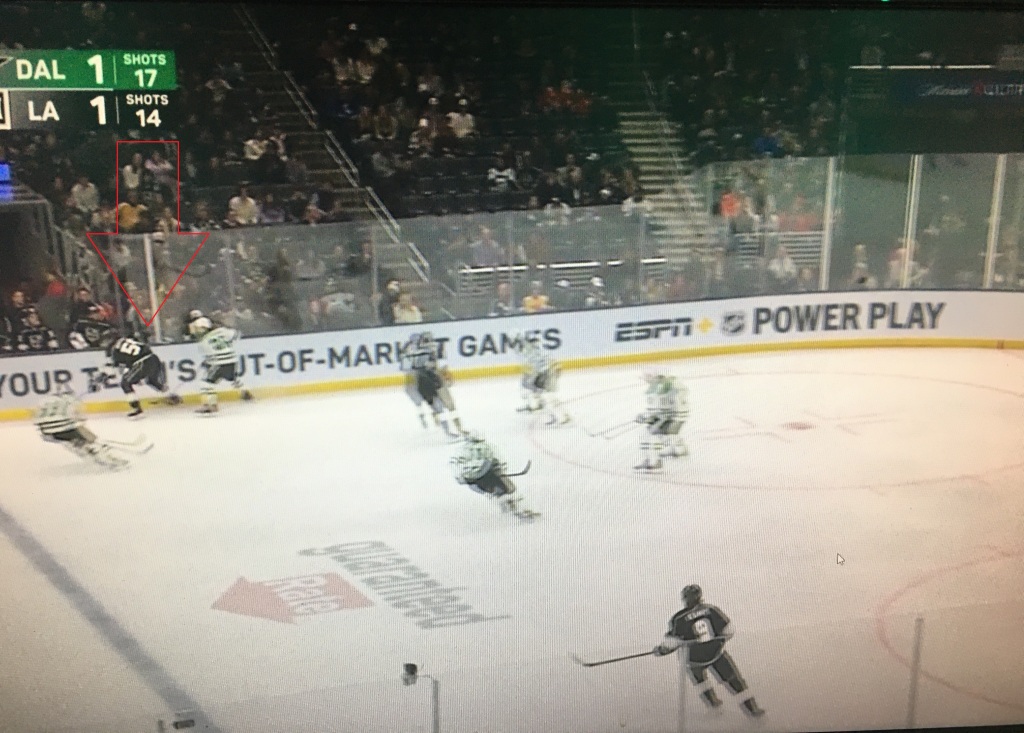
Before now chipping the puck to Kopitar with two forecheckers already in the zone:

Again, though, the attack stalls out as the Dallas goalie intercepts Kopitar’s proceeding board pass and Dallas moves the puck out of the zone.
AND YET Byfield doesn’t stop there. So far this shift, he has already curled deep in his zone to push the defenders off his puck-carrier, chased down the ice, regrouped in the neutral zone, and made a nifty blue-line play. He has had a big hand on one clean entry and another that should have been clean were it not for a turnover by a teammate. To cap off this very same shift, Byfield races across the ice to pressure Dallas’s Tyler Seguin:

Byfield eats Seguin’s lunch here and tips the puck to Kempe, who is providing back-side support (i.e. slower on the backcheck):

Kempe fires a cross-ice pass to Kopitar, who gains the zone cleanly (thanks again for the backcheck, Mr. Byfield):

Kopitar chips the puck back to Mikey Anderson, who one-times the puck on net. As this is happening, though, Byfield is racing back into the offensive zone, about 30 feet ahead of Seguin, whom he had just cleaned out, and no one is paying attention to him because of it:

Byfield does something very smart here: he doesn’t skate to the front of the net, or get caught leaking towards the puck on the strong side. He slows down a bit, anticipating Anderson’s one-timer to kick out a rebound. It doesn’t go to Byfield, but because he has slowed and stayed in an open space, he can chase down the rebound that goes to the boards with lots of time to make a play:

Byfield eventually kicks the puck back to defenceman Drew Doughty, who fires a puck on net:

That shot is redirected by Kopitar for a goal to give the Kings their lead back. Kempe would score a power-play goal in the third period to lift the team to the 3-2 win.
One shift from Byfield resulted in two clean entries on three attempts, and the failed entry was a missed pass made by Kempe. They didn’t generate a lot of dangerous scoring chances, but they wouldn’t have generated any shots at all had it not been for the skilled, tireless-yet-patient play from the 20-year-old Byfield. Those are the types of shots the team was taking earlier in the year, but they wouldn’t have been generated at all were it not for the 2020 second overall selection.
Moving to the Winnipeg game, the line scored four goals, though one was on the power play, and one was without Kempe on the ice. Let’s look at the first 5-on-5 goal.
It’s nearly halfway through the game and Los Angeles is down 3-1. The Kings’ fourth line was pinned on the ice for an extended shift, but had made partial changes. Arthur Kaliyev was the last guy to change, but got the puck in the neutral zone and dumped it in to head off the ice as Kopitar races in:
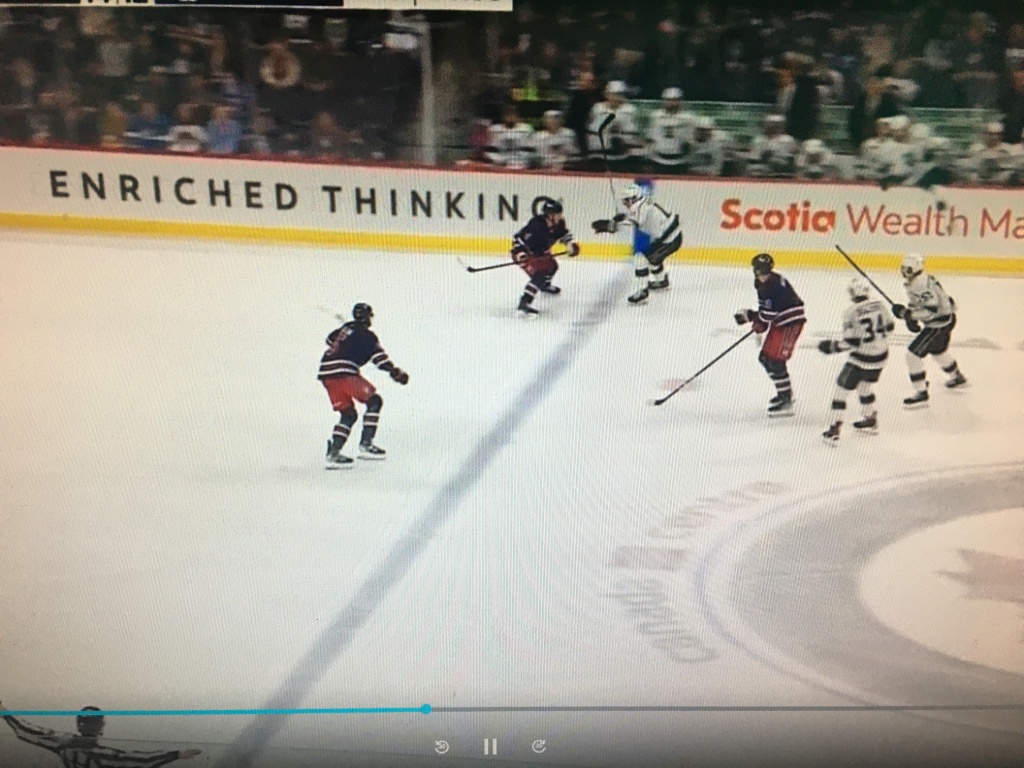
Ok, we’ve seen this before. Why is this different? Well, first off, Kopitar gets in first on the forecheck, which is not what we saw Kempe do earlier. This gets the puck pinned on the boards, ensuring the puck isn’t immediately retrieved by Winnipeg and giving Kopitar’s teammates time to support him:

And there we see Mr. Byfield, hanging around looking for a loose puck:

One thing that sticks out whenever we watch him is that he is a puck-hound. He will always seek it out, and will make life hard on the defence, even if he doesn’t chase down the puck directly. He is directly pressuring here, though, and this pressure, aided by a bit of a flub by Jets defenceman Saku Mäenalanen, gets the puck back on Byfield’s stick. Then he does something a lot of Kings players didn’t seem to be doing: he makes the extra move. The Winnipeg forward goes to apply pressure:

But Byfield goes around him like a pylon and it gives him a clean line of sight to dish to Kings defenceman Alex Edler:

This results in a point shot from Edler that is deflected by Kopitar for a goal. Yes, it’s another point shot, but the difference here, again, is this point shot likely wouldn’t have happened three months earlier. The forecheck could have very easily stalled out off the Kaliyev dump-in and the team is immediately on the defensive. Instead, Kopitar gets in hard on the forecheck, he’s immediately supported by Byfield, and the extra move from the forward gives them an extra shot they never would have had. Yes, we’d like to see a tic-tac-toe scoring play, but this is one example of how the Kings were able to create some offence in a situation they struggled earlier in the year. The Kings would win that game 6-5 thanks to a monster performance from the top line.
It is pretty obvious that Byfield has had a massive impact not only on the top line, but on the team as a whole. How effective he ends up being in the postseason is an open question right now, and I don’t want to expect too much from a 20-year-old that has fewer than 100 NHL regular season games. He has also endured injuries that have slowed his development a bit and how much he has in the tank at the toughest time of year for NHLers is fair to wonder.
With all that said, Byfield is an absolute forechecking menace, but he also has the skill and the smarts to make extra plays that other forecheckers cannot. This isn’t a guy that just skates fast and bangs into defencemen. Well, he can do that, but he can also make tight-space moves and see the ice very well, which helps him anticipate where to go next, and not focus only on where he is now.
To be sure, we’re looking at just a handful of games, and a handful of shifts, across a season that featured 82 Kings games and thousands of shifts. There is a lot more to the story than what is told here, but this should help readers glimpse into why Byfield has remained on the top line for months after struggling down the lineup. It’s not that they don’t have other options, it’s that he’s their best option for that spot, and he’s running with the opportunity. Not only that, but when everyone is healthy, it allows them to move Vilardi and Fiala down the lineup to give them three legitimate scoring lines.
What the future holds for Byfield is certainly up for debate. Is he a Nino Niederreiter-type? Is he a Joel Eriksson Ek-type? Is he Sean Couturier-type? They are all scoring forecheckers, but all play a different style.
Or maybe he just ends up being the Byfield-type that future NHL stars will emulate 10 years down the road.